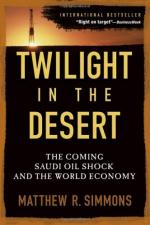
|
| Name: _________________________ | Period: ___________________ |
This test consists of 15 multiple choice questions and 5 short answer questions.
Multiple Choice Questions
1. A SPE paper says that the best approach to steadily increasing water cuts is to choke back what?
(a) A well's rate of production.
(b) A well's drilling speed.
(c) A well's drilling depth.
(d) A well's purification efforts.
2. By using the history of other fields around the world, the author hopes to make what point?
(a) That the end of Saudi Arabia's oil days is bad for the Saudi people.
(b) That the end of Saudi Arabia's oil days are near.
(c) That the end of Saudi Arabia's oil days means no more oil in the world.
(d) That the end of Saudi Arabia's oil days isn't the end of oil.
3. When was Hawtah Trend discovered?
(a) 2001.
(b) 1996.
(c) 1992.
(d) 1989.
4. When free-flowing oil in Saudi Arabia ends, what is the only alternative to find oil?
(a) Shale and surface drilling.
(b) Cleanup efforts.
(c) Secondary recovery efforts.
(d) Rehabilitation efforts.
5. What is one of the most important uses of natural gas in Saudi Arabia today?
(a) To power remote medical clinics.
(b) To power the larger urban centers.
(c) To power desalination plants.
(d) To power the oil drills.
6. Overproduction and what have contributed to an early decline in production in Russian oil fields?
(a) Poor management.
(b) Lack of technology.
(c) Damage to the surrounding areas.
(d) Civil wars.
7. At the October 2003 SPE conference, how many papers were presented by Saudi Arabian authors?
(a) 9.
(b) 14.
(c) 12.
(d) 17.
8. What kind of logic describes the black and white area of interpretation?
(a) Fuzzy logic.
(b) Logical logic.
(c) Problematic logic.
(d) Clear logic.
9. Since what year has there been very little data available to verify production levels in Saudi Arabia?
(a) 1987.
(b) 1993.
(c) 1982.
(d) 1979.
10. Where are some of the other giant oil fields in the world, besides Saudi Arabia?
(a) Germany.
(b) Japan.
(c) Norway.
(d) Sweden.
11. Development of oil in Shaybah is what?
(a) Technologically dependent and expensive.
(b) A sure thing.
(c) Complex and risky.
(d) Inexpensive but labor intensive.
12. Instead of helping to recover more oil from older fields, technology has done what?
(a) Enabled oil to be recovered from remote places.
(b) Enabled oil to be recovered more purely.
(c) Enabled oil to be recovered without so much damage.
(d) Enabled oil to be recovered more quickly.
13. In the 1950's natural gas was seen as a useful product for what?
(a) Maintaining reservoir pressure.
(b) Fueling oil drills.
(c) Keeping oil pure.
(d) Identifying problems in oil fields.
14. How much unexplored area is there in Saudi Arabia?
(a) Very little.
(b) Some.
(c) None.
(d) A lot.
15. One of the discoveries made between 2004 and 2006 is known as what type of reserve?
(a) Natural gas-only.
(b) Gas-only.
(c) Oil-only.
(d) Crude-only.
Short Answer Questions
1. What makes it unlikely that the papers presented to the SPE are exaggerations to make the authors look impressive?
2. What position does Abdullah Jumah hold in the Saudi Arabian oil company?
3. How many new discoveries are on Saudi Arabia's official list of developments?
4. Why is the most accurate way to determine the true potential of a reserve rarely done?
5. What kind of crisis will occur if Saudi Arabian oil production declines sharply?
|
This section contains 532 words (approx. 2 pages at 300 words per page) |

|




